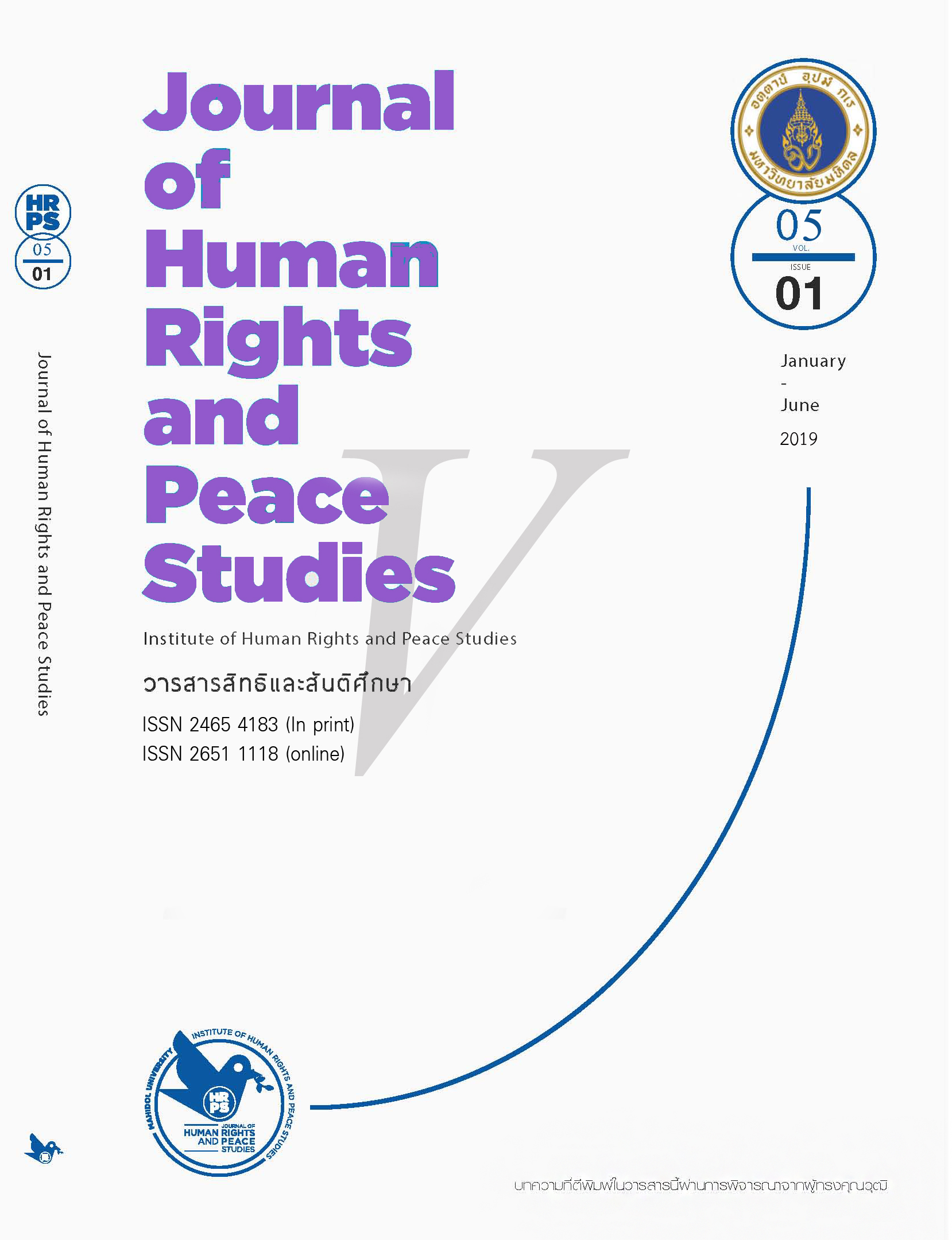History of Prejudice Patriarchy, Asceticism and The Bias to Women in Buddhism after The Buddha’s death
Main Article Content
Abstract
This research paper is developed from my research; Women’s rights in Theravada Buddhism, a critical study of the Theravada’s perspective on women's rights, status, duties and in socio-economic - political roles as portrayed in the Pali Tipitaka and other related Buddhist texts. The focus of the study is Early Buddhism in India up to 700 C.E., But in this paper, I would like to present some prejudice to women appeared in Theravada and Mahayana Buddhism.
In Theravada literatures, There were no direct teachings with respect to women’s socio-economic-political status, rights and roles. But there existed some interpretable teachings which illustrated some places in the universe that women could not get into. In Theravada Buddhist perspective, women should not be allowed to get involved in any socio-economic and political matters. It is noted that Theravada literatures collected in the later periods of time depicted more negative portraits of women when compared to the earlier ones. It is true that Buddhism in both early and later periods has been significantly influenced by the patriarchy culture in India. The negative images of women were increasingly portrayed due to the influences of asceticism which, to a certain extent, were associated with the patriarchy culture.
Article Details
The views, opinions, and pictures expressed in this journal are those of the authors and do not necessarily reflect the opinions and viewpoints of the editor and the editorial board. All rights are reserved by the authors and the Institute of Human Rights and Peace Studies of Mahidol University. No part of this journal may be reproduced, stored in a retrieval system, or transmitted in any form or by any means without the prior permission in writing from the journal’s editor, or as expressly permitted by law, or under terms agreed with the appropriate reprographics rights organization. Non-commercial use of information in this journal must be properly referenced.
References
คอนซ์, เอ็ดเวิร์ด. (2530). พุทธศาสนา สารและพัฒนาการ. (นิธิ เอียวศรีวงศ์, ผู้แปล). กรุงเทพฯ: อมรินทร์ พริ้นติ้ง กรุ๊ฟ.
ฉัตรสุมาลย์ กบิลสิงห์. (ผู้แปล). (2537). สัทธรรมปุณฑรีกสูตร. กรุงเทพฯ: ศูนย์ไทย-ธิเบต.
ฉัตรสุมาลย์ กบิลสิงห์. (ผู้แปล). (2554). ศรีมาลาเทวีศรีหนาทสูตร. กรุงเทพฯ: ศูนย์ไทย-ธิเบต.
ณัชปภา วาสิงหน (2555). ความเข้าใจเกี่ยวกับพุทธประสงค์ในการประดิษฐานภิกษุณีสงฆ์. วารสารพุทธศาสน์ศึกษา, 19(3), 43-63.
ทวีวัฒน์ ปุณฑริกวิวัฒน์. (2543). พุทธศาสนากับสิทธิสตรี. วารสารมหาวิทยาลัยศิลปากร, 19-20(1), 101-132.
ปรีชา ช้างขวัญยืน. (2541). สตรีในคัมภีร์ตะวันออก. กรุงเทพฯ: จุฬาลงกรณ์มหาวิทยาลัย.
พระเทพเวที (ประยุทธ์ ปยุตโต). (2536). จารึกอโศก. ใน ส. ศิวรักษ์ (ผู้แปลและเรียบเรียง), ความเข้าใจเรื่องพระเจ้าอโศกและอโศกาวทาน (หน้า 216-260). กรุงเทพฯ: ศูนย์ไทย-ธิเบต.
พระเทพเวที (ประยุทธ์ ปยุตโต). (2532). การศึกษาที่สากลบนฐานแห่งภูมิปัญญาไทย. กรุงเทพฯ: อมรินทร์ พริ้นติ้ง กรุ๊ฟ.
พระศรีปริยัติโมลี (สมชัย กุสลจิตฺโต). (บรรณาธิการ). (2544). สตรีในพระพุทธศาสนา. กรุงเทพฯ: สุขภาพใจ.
พิทักษ์พงศ์. (2544). คอลัมน์ "สู่โพธิสัตต์มรรค." ข่าวรายสัปดาห์อาทิตย์ 23, 1158: 1-7 มีนาคม 2544. 30-31.
มหามกุฎราชวิทยาลัย. (2525). พระสูตรและอรรถกถาแปล ขุททกนิกายชาดก (เล่มที่ 3 ภาคที่ 1). กรุงเทพฯ: เฉลิมชาญการพิมพ์.
มหามกุฎราชวิทยาลัย. (2525). พระสูตรและอรรถกถาแปล ขุททกนิกายชาดก (เล่มที่ 4 ภาคที่ 3). กรุงเทพฯ: เฉลิมชาญการพิมพ์.
มหามกุฎราชวิทยาลัย. (2530). สยามรฏฐสส เตปิฏกํ. กรุงเทพฯ: โรงพิมพ์มหามกุฎราชวิทยาลัย.
มหามกุฏราชวิทยาลัย. (2542). พระธัมมปทัฏฐกถาแปล (ภาค 1-2). กรุงเทพฯ: มหามกุฏราชวิทยาลัย.
เมตตานันโท ภิกขุ. (2545). เหตุเกิด พ.ศ. 1.เล่ม 2 . กรุงเทพฯ: แสงพระอาทิตย์.
ราชบัณฑิตยสถาน. (2532). พจนานุกรมศัพท์ปรัชญา อังกฤษ-ไทย ฉบับราชบัณฑิตยสถาน. กรุงเทพฯ: อมรินทร์ พริ้นติ้ง กรุ๊พ.
ส. ศิวรักษ์ (ผู้แปลและเรียบเรียง). (2534). ความเข้าใจเรื่องพระเจ้าอโศกและอโศกาวาทาน. กรุงเทพฯ: ศูนย์ไทย-ธิเบต.
สามเณรีธัมมนันทา (ฉัตรสุมาลย์ กบิลสิงห์). (2544). คุยกับพระผู้หญิง. กรุงเทพฯ: พระอาทิตย์.
สำนักคอมพิวเตอร์. มหาวิทยาลัยมหิดล. (2537). พระไตรปิฎกฉบับคอมพิวเตอร์. (ชุดแปลเป็นภาษาไทย เวอร์ชั่น 2).
สุชีพ ปุญญานุภาพ. (2539). พระไตรปิฎกฉบับสำหรับประชาชน. กรุงเทพฯ: มหามกุฎราชวิทยาลัย.
สุนทร ณ รังสี (2541). พุทธปรัชญาจากพระไตรปิฎก. กรุงเทพฯ: จุฬาลงกรณ์มหาวิทยาลัย.
เสถียร โพธินันทะ. (2513). ประวัติศาสตร์พระพุทธศาสนา. พระนคร: บรรณาคาร.
เสถียร โพธินันทะ. (2516). ชุมนุมพระสูตรมหายาน. กรุงเทพฯ: บรรณาคาร.
Blackstone, K. (1991). Damming the dhamma: Problems with Bhikkhuniis in the Pali Vinaya. Retrieved from https://budsas.net/ebud/ebsut066.htm
Gross, R. M. (1995). Buddhism after patriarchy. India: Sri Satguru.
Satha-Anand, S. (2001). Female ordination and women’s rights in buddhism. Humanitas Asiatica, 2(1), 98-104.
Sponberg, A. (1985). Attitudes toward women and the feminine in early buddhism. In J. I. Cabezon, (Ed.), Buddhism, sexuality, and gender. Albany, N.Y.: State University of New York Press.
William, P. (1989). Mahayana Buddhism: The doctrinal foundations. London: Routledge.


